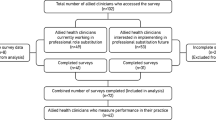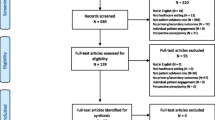Abstract
In many parts of the world the practice of medicine and medical education increasingly focus on providing patient care within context of the larger healthcare system. Our purpose is to solicit perceptions of all professional stakeholders (e.g. nurses) of the system regarding the U.S. ACGME competency Systems Based Practice to uncover the extent to which there is agreement or discrepancy among key system stakeholders. Eighty-eight multidisciplinary personnel (n = 88) from two academic medical centers were invited to participate in one of 14 nominal group process sessions. Participants generated and prioritized resident characteristics that they believed were important for effective System Based Practices. Through content analysis the prioritized attribute statements were coded to identify embedded themes of resident roles and behavior. From the themes, three major resident roles emerged: resident as Self-Manager, Team Collaborator, and Patient Advocate. No one professional group (e.g., nurses, attending physicians, social workers) emphasized all of these roles. Some concepts that are emphasized in the ACGME definition like using cost–benefit analysis were conspicuously absent from the healthcare team generated list. We showed that there are gaps between the key stakeholders prioritizations about the ACGME definition of SBP and, more generally, the behaviors and roles identified by healthcare team stakeholders beyond the U.S. This suggests that within the process of developing a comprehensive working understanding of the Systems Based Practice competency (or other similar competencies, such as in CanMEDS), it is necessary to use multiple stakeholders in the system (perhaps including patients) to more accurately identify key resident roles and observable behaviors.
Similar content being viewed by others
Notes
Five other competency areas designated by ACGME are Medical Knowledge, Professionalism, Patient Care, Interpersonal and Communication Skills, and Practice-Based Learning and Improvement.
References
ACGME outcomes project webpage (2007). Viewed 10 Sept. 2007. http://www.acgme.org/outcome/compFull.asp#6
American College of Physicians (ACP) (2008). Achieving a high-performance health care system with universal access: What the United States can learn from other countries. Annals of Internal Medicine, 148(1), 55–75.
Aspinal, F., et al. (2005). What is important to measure in the last months and weeks of life?: A modified nominal group study. International Journal of Nursing Students.
Baker, L. M. (2004). Information needs at the end of life: A content analysis of one person’s story. Journal of the Medical Librarians Association, 92(1), 78–82.
Bleakley, A. (2007). Medical education in transition and the patient as transitional object. Graduate Medical Education Plenary presentation. Washington, D.C.: Association of American Medical Colleges.
Carney, O., McIntosh, J., & Worth, A. (1996). The use of the Nominal Group Technique in research with community nurses. Journal of Advanced Nursing, 23(5), 1024–1029.
Chatterji, M. (2004). Evidence on “What Works”: An argument for extended-term mixed-method (etmm) evaluation designs. Educational Researcher, 34(5), 14–24.
David, R. A., & Reich, L. M. (2005). The creation and evaluation of a systems-based practice/managed care curriculum in a primary care internal medicine residency program. Mt Sinai Journal of Medicine, 72(5), 296–299.
Dyne, P. L., Strauss, R. W., & Rinnert, S. (2002). Systems-based practice: The sixth core competency. Academic Emergency Medicine, 9(11), 1270–1277.
Englander, R., Agostinucci, W., Zalneraiti, E., & Carraccio, C. L. (2006). Teaching residents systems-based practice through a hospital cost-reduction program: A “win-win” situation. Teaching and Learning in Medicine, 18(2), 150–152.
Epstein, R. M. (2007). Assessment in medical education. The New England Journal of Medicine, 356(4), 387–396.
Frank J. R. (Ed.). (2005). The CanMEDS 2005 physician competency framework. Better standards. Better physicians. Better care. Ottawa: The Royal College of Physicians and Surgeons of Canada.
Frank, J. R., & Danoff, D. (2007). The CanMEDS initiative: Implementing an outcomes-based framework of physician competencies. Medical Teacher, 29, 642–647.
Legrow, K., & Rossen, B. E. (2005). Development of professional practice based on a family systems nursing framework: Nurses’ and families’ experiences. Journal of Family Nursing, 11(1), 38–58.
General Medical Council (GMC) [Great Britain]. Good medical practice. (2006). http://www.gmc-uk.org/guidance/good_medical_practice/index.asp. Viewed on Jan. 29, 2008.
Institute of Medicine, Committee on Quality of Health Care in America (2001). Crossing the quality chasm: A new health system for the 21st century. Washington, D.C.: National Academy Press.
Kvarnstorm, S., & Cedersund, E. (2006). Discursive patterns in multiprofessional healthcare teams. Journal of Advanced Nursing, 53(2), 244–252.
Lancet (2001). Educating doctors for world health. Lancet: London, 358(9292), 3 November 2001.
Lingard, L., Espin, S., Evans, C., & Hawryluck, L. (2004). The rules of the game: Interprofessional collaboration on the intensive care unit team. Critical Care, 8(6), R403–R408.
Moon, R. H. (1999). Finding diamonds in the trenches with the nominal group process. Family Practice Management, 6(5), 49–50.
Owen J. W., & Roberts O. (2005) Globalization, health, and foreign policy: Emerging linkages and interests. Globalization and Health, 1(12), 1744–8603 2005.
Panek, R. C., Deloney, L. A., Park, J., Goodwin, W., Klein, S., & Ferris, E. J. (2006). Interdepartmental problem-solving as a method for teaching and learning systems-based practice. Academic Radiology, 13(9), 1150–1154.
Palmer, K. T., Harling, C. C., Harrison, J., Macdonald, E. B., & Snashall, D. C. (2002). Good medical practice: Guidance for occupational physicians. Occupational Medicine, 52(6), 341–352.
Pasquina, P. F., Kelly, S., & Hawkins, R. E. (2003). Assessing clinical competence in physical medicine & rehabilitation residency programs. American Journal of Physical Medicine Rehabilitation, 82(6), 473–478.
Ranz, J. M., Vergare, M. J., Wilk, J. E., Ackerman, S. H., Lippincott, R. C., Menninger, W. W., et al. (2006). The tipping point from private practice to publicly funded settings for early- and mid-career psychiatrists. Psychiatric Service, 57(11), 1640–1643.
Reisdorff, E. J., Hayes, O. W., Walker, G. L., & Carlson, D. J. (2002). Evaluating systems-based practice in emergency medicine. Academic Emergency Medicine, 9(11), 1350–1354.
Ringsted, C., Hansen, T. L., Davis, D., & Schepbier, A. (2006). Are some of the challenging aspects of the CanMEDS roles valide outside Canada? Medical Education, 40, 807–815.
Romanow, R. (2002). Building on values: The future of health care in Canada. Commission on the Future of Health Care in Canada.
Saleh, K. J., Macaulay, A., Radosevich, D. M., Clark, C. R., Engh, G., Gross, A., et al. (2001). The Knee Society Index of Severity for failed total knee arthroplasty: Development and validation. Clinical Orthopedics Related Research, (392), 153–165.
Swing, S. R. (2002). Assessing the ACGME general competencies: General considerations and assessment methods. Academic Emergency Medicine, 9(11), 1278–1288.
Tomolo, A., Caron, A., Perz, M. L., Fultz, T., & Aron, D. C. (2005). The outcomes card. Development of a systems-based practice educational tool. Journal of General Internal Medicine, 20(8), 769–771.
Zenni, E. A., Ravago, L., Ewart, C., Livingood, W., Wood, D., & Goldhagen, J. (2006). A walk in the patients’ shoes: A step toward competency development in systems-based practice. Ambulatory Pediatrics, 6(1), 54–57.
Acknowledgements
The Stemmler Fund for Medical Education Research from the National Board of Medical Examiners supported this research. All findings and statements are, however, the sole opinions of the authors. We thank all the health team members for making time to participate in this study. We also thank Gingi Pica, Sarah Steinberg, and Brianna Moore for their help with data collection and analysis for this project. We acknowledge the thoughtful critiques of an earlier draft of this manuscript by Glenn Regehr, Sharon Krackov, Boyd Richards, and two anonymous reviewers.
Author information
Authors and Affiliations
Corresponding author
Appendix A
Appendix A
The Accreditation Council of Graduate Medical Education’s definiition of systems-based practice
Residents must demonstrate an awareness of and responsiveness to the larger context and system of health care, as well as the ability to call effectively on other resources in the system to provide optimal health care. Residents are expected to:
-
work effectively in various health care delivery settings and systems relevant to their clinical specialty;
-
coordinate patient care within the health care system relevant to their clinical specialty;
-
incorporate considerations of cost awareness and risk-benefit analysis in patient and/or population-based care as appropriate;
-
advocate for quality patient care and optimal patient care systems;
-
work in inter-professional teams to enhance patient safety and improve patient care quality; and
-
participate in identifying system errors and implementing potential systems solutions.
Rights and permissions
About this article
Cite this article
Graham, M.J., Naqvi, Z., Encandela, J.A. et al. What indicates competency in systems based practice? An analysis of perspective consistency among healthcare team members. Adv in Health Sci Educ 14, 187–203 (2009). https://doi.org/10.1007/s10459-008-9106-6
Received:
Accepted:
Published:
Issue Date:
DOI: https://doi.org/10.1007/s10459-008-9106-6




